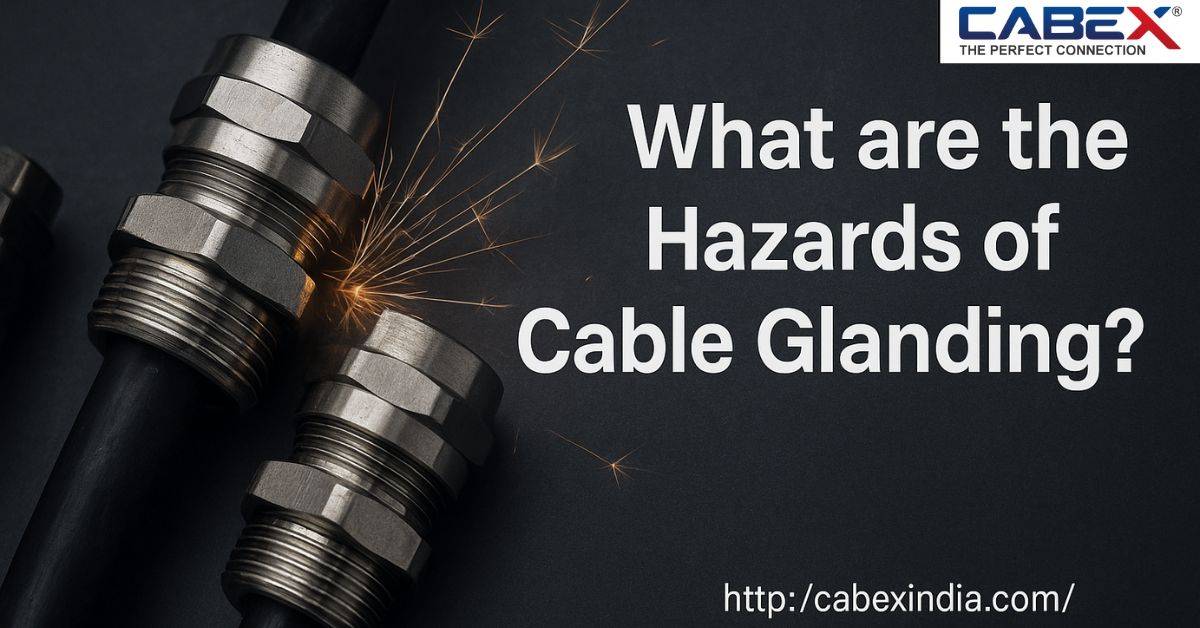Introduction: Why Cable Glanding Hazards Should Never Be Ignored
Cable glanding is a small yet critical part of any electrical installation, especially in hazardous and industrial environments. If not handled properly, it can lead to serious safety risks such as electric shocks, fire, or even explosions. Whether you’re dealing with Hazardous Area Cable systems or installing industrial cable glands, understanding the associated hazards is essential.
In high-risk environments like oil refineries, chemical plants, or factories, the failure of Cable glands can disrupt operations, damage property, and endanger lives. This is why choosing the right cable gland, installing it correctly, and maintaining it regularly is crucial for long-term electrical safety.
Top Hazards of Cable Glanding
Let’s break down the most common hazards caused by improper cable Glanding, especially in hazardous area cable and industrial cable gland applications:
1. Moisture and Dust Ingress
Improper sealing can allow dust, water, or gases to enter electrical enclosures. In hazardous areas, this may trigger explosions or short circuits. Always use IP66 or IP68-rated glands for better sealing performance.
Key Tip: For Hazardous Area Cable Installations, always choose flameproof or explosion-proof glands.
2. Cable Pullout and Mechanical Damage
In industrial environments, continuous vibrations or mechanical stress can cause cables to loosen or pull out from the gland. This can expose live conductors, leading to electrical hazards.
Pro Tip: Use Industrial cable glands with strain relief features to prevent slippage and stress.
3. Electrical Fault Due to Improper Earthing
Armoured cables need effective earthing. If the gland fails to maintain earth continuity, it may result in electric shocks or faults.
Use Case: In panels using metallic cable glands, proper grounding accessories are a must.
4. Explosion in Hazardous Areas
In volatile environments, even a small spark can cause an explosion. Poor-quality or incorrectly fitted glands increase the risk drastically.
Best Practice: Always use certified glands (ATEX, IECEx) for hazardous area cable installations.
5. Material Degradation or Corrosion
Using low-grade or non-resistant materials in corrosive zones can cause the gland to degrade. This compromises sealing and structural strength over time.
Solution: For chemical or offshore sites, opt for stainless steel or nickel-plated industrial cable glands.
How to Prevent Cable Glanding Hazards
Avoiding these hazards is possible with the right practices:
Select the Right Gland Type
- Use explosion-proof glands for hazardous area cable use
- Choose strain-relief glands in vibration-heavy zones
- Use UV- and corrosion-resistant materials for outdoor use
Match Glands to Cable Types
- Always check the gland size, sealing range, and cable compatibility
- Avoid loose or tight fittings that can cause insulation damage
You May Also Like: How To Prevent Cable Damage in Hazardous Environments , How to Install Lightning Arrester for Home?
Ensure Correct Installation
- Follow torque ratings and use sealing washers/shrouds
- Use locknuts to prevent gland movement
Regular Inspection and Maintenance
- Check for signs of corrosion, loosening, or leakage
- Replace glands if damaged or outdated
What Makes Cabex India Your Best Choice?
Cabex India offers a wide range of high-performance industrial cable glands and accessories that meet global certifications (ATEX, IECEx, UL, CE). Our solutions are tailored to suit high-risk industries such as oil & gas, manufacturing, power plants, and marine applications.
Why Choose Cabex:
- Explosion-proof glands for hazardous area cable installations
- IP-rated glands for dust and water protection
- Durable materials like stainless steel, brass, and polymer
- Expert guidance for product selection
Comparison of Cable Gland Risks and Solutions
| Hazard | Cause | Solution |
| Dust or water ingress | Poor sealing or wrong IP rating | Use IP66/IP68-rated glands |
| Cable pullout | Incorrect gland size or lack of strain relief | Use glands with proper grip and mechanical support |
| Electrical shock or fault | No proper grounding | Use glands with earth continuity and check bonding |
| Explosion in hazardous area | Gas ingress or sparking | Use certified flameproof cable glands |
| Material degradation | Corrosion due to environment | Choose corrosion-resistant gland materials |
Conclusion:
Cable glanding hazards are often underestimated, but they can lead to catastrophic consequences if ignored. Whether your project involves hazardous area cable systems or relies on industrial cable glands, it’s essential to focus on the correct gland type, proper installation, and regular maintenance.
Trust Cabex India for:
- Certified, durable, and safe cable glands
- Reliable support for industrial and hazardous applications
- End-to-end safety solutions for all your cable management needs
Let Cabex India secure your installations—because safety starts with the right connection.
FAQs
1. What is a hazardous area cable, and why is it risky?
A hazardous area cable is used in environments where flammable gases, vapours, or dust may be present. If not installed with explosion-proof glands, even a small spark can lead to severe explosions.
2. Are all cable glands suitable for industrial use?
No. Industrial cable glands are specifically designed for high mechanical stress and environmental exposure. Always choose glands with appropriate IP and material ratings for the application.
3. Can a wrong-sized cable gland cause accidents?
Yes. A gland that is too loose or too tight can damage the cable or cause it to slip, which may expose live wires and result in electric shocks, short circuits, or fires.
4. How often should cable glands be checked?
In hazardous or industrial zones, cable glands should be inspected every 3–6 months for signs of corrosion, loosening, or failure in sealing. Preventive maintenance improves safety and longevity.
5. What certifications should I look for when buying cable glands?
Look for ATEX, IECEx, UL, or CE certifications for hazardous area cable glands. These indicate that the product meets international safety and performance standards.




